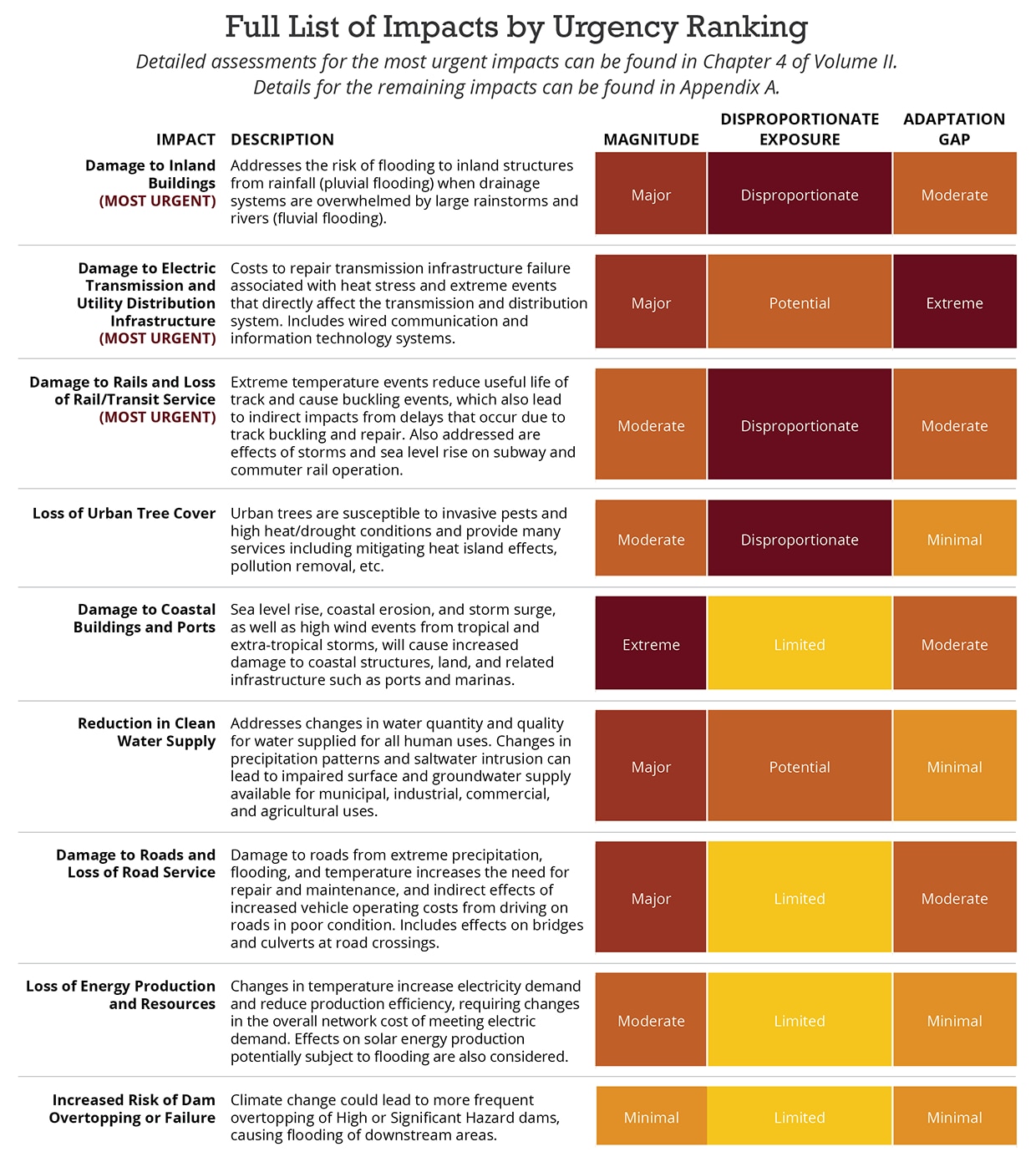Overview
This Climate Assessment considers impacts across five sectors which represent major categories of projected impacts of climate change with common groupings of exposed assets, individuals, or resources, and that generally fall under the responsibility of similar state agencies. The primary objective of the Climate Assessment is to identify urgent climate risk statewide, as well as by each region and sector. Risk rankings were developed through discussions with the project working group and stakeholders, and considered:
-
How big of a climate effect will this have? Quantitative and qualitative indicators of the scale of potential impact, analyzed under the defined future climate scenario.
-
Will populations living in environmental justice areas be disproportionately affected? Demographic analysis of the distribution of impact across populations, particularly the Commonwealth’s identified environmental justice and socially vulnerable groups.
-
Are we currently doing enough to adapt to this impact? Assessment of current and planned adaptation plans and actions, and the potential benefits of additional adaptation action.
Sectors are a helpful organizational structure and allow for the prioritization across impacts with similar types of effects. However, it is important to note that the effects of climate change do not fall neatly within the defined sectors, and there are many interactions between impacts both within and across sectors. To the extent possible, these interactions are noted in the Climate Assessment in order to help draw these connections that may not be seen in the quantitative sectoral analysis.
Full List of Impacts in the Infrastructure Sector
Nine impacts were evaluated within the Infrastructure Sector. Detailed assessments for the most urgent impacts can be found below and in Chapter 4 of Volume II. Details for the remaining impacts can be found in Appendix A.
Most Urgent Impact: Damage to Inland Buildings
Addresses the risk of flooding to inland structures from rainfall when drainage systems are overwhelmed by large rainstorms, or by rivers affecting buildings in the floodplain.
Major Level of Consequence
Inland residential property damage may increase by 4 percent over baseline by 2050.
Disproportional Exposure
Disproportional exposure for low income (24 percent) and language isolation (39 percent) is high.
Moderate Adaptation Gap
Nature-based stormwater management options are being implemented across the state, but regulatory support for building adaptation is lagging.
Most Urgent Impact: Damage to Electric Transmission and Utility Distribution Infrastructure
Costs to repair transmission infrastructure failure associated with heat stress and extreme events that directly affect the transmission and distribution system. Includes wired communication and information technology systems.
Major Level of Consequence
Repair costs for electric transmission and distribution infrastructure are projected to increase by $87 million per year by 2050.
Potential for Disproportionality
Repair costs for electricity infrastructure are not concentrated in EJ areas.
Extreme Adaptation Gap
Some focus on increasing grid reliability with back up energy sources, little on grid infrastructure resilience.
Most Urgent Impact: Damage to Rails and Loss of Rail/Transit Service
Extreme temperature events reduce useful life of track and cause buckling events, which also lead to indirect impacts from delays that occur due to track buckling and repair. Also addressed are effects of storms and sea level rise on subway and commuter rail operation.
Moderate Level of Consequence
Rail repair costs could reach up to $6 million per year by 2050 and $35 million per year by end of century.
Disproportionate Exposure
EJ block groups defined on the basis of minority population have 24 percent higher exposure to rail maintenance costs than the rest of the Commonwealth.
Moderate Adaptation Gap
Adaptation strategies are available but costly, and little action has been taken.
Quick links
- ResilientMass Homepage
- ResilientMass Site Map
- Massachusetts Climate Change Assessment
- Massachusetts Climate Change Assessment – Human Sector
- Massachusetts Climate Change Assessment – Natural Environment Sector
- Massachusetts Climate Change Assessment – Governance Sector
- Massachusetts Climate Change Assessment – Economy Sector
- Massachusetts Climate Change Assessment – Full Statewide Report Volume II
- Massachusetts Climate Change Assessment – Full Statewide Report Volume II, Appendix A
- 2023 ResilientMass Plan
- 2023 ResilientMass Action Tracker





